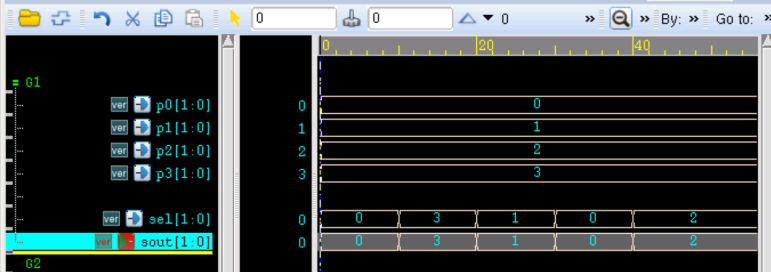关键词:if,选择器
条件语句
条件(if)语句用于控制执行语句要根据条件判断来确定是否执行。
条件语句用关键字 if 和 else 来声明,条件表达式必须在圆括号中。
条件语句使用结构说明如下:
if (condition1) true_statement1 ;
else if (condition2) true_statement2 ;
else if (condition3) true_statement3 ;
else default_statement ;
- if 语句执行时,如果 condition1 为真,则执行 true_statement1 ;如果 condition1 为假,condition2 为真,则执行 true_statement2;依次类推。
- else if 与 else 结构可以省略,即可以只有一个 if 条件判断和一组执行语句 ture_statement1 就可以构成一个执行过程。
- else if 可以叠加多个,不仅限于 1 或 2 个。
- ture_statement1 等执行语句可以是一条语句,也可以是多条。如果是多条执行语句,则需要用 begin 与 end 关键字进行说明。
下面代码实现了一个 4 路选择器的功能。
实例
module mux4to1(
input [1:0] sel ,
input [1:0] p0 ,
input [1:0] p1 ,
input [1:0] p2 ,
input [1:0] p3 ,
output [1:0] sout);
reg [1:0] sout_t ;
always @(*) begin
if (sel == 2'b00)
sout_t = p0 ;
else if (sel == 2'b01)
sout_t = p1 ;
else if (sel == 2'b10)
sout_t = p2 ;
else
sout_t = p3 ;
end
assign sout = sout_t ;
endmodule
module mux4to1(
input [1:0] sel ,
input [1:0] p0 ,
input [1:0] p1 ,
input [1:0] p2 ,
input [1:0] p3 ,
output [1:0] sout);
reg [1:0] sout_t ;
always @(*) begin
if (sel == 2'b00)
sout_t = p0 ;
else if (sel == 2'b01)
sout_t = p1 ;
else if (sel == 2'b10)
sout_t = p2 ;
else
sout_t = p3 ;
end
assign sout = sout_t ;
endmodule
testbench 代码如下:
实例
`timescale 1ns/1ns
module test ;
reg [1:0] sel ;
wire [1:0] sout ;
initial begin
sel = 0 ;
#10 sel = 3 ;
#10 sel = 1 ;
#10 sel = 0 ;
#10 sel = 2 ;
end
mux4to1 u_mux4to1 (
.sel (sel),
.p0 (2'b00), //path0 are assigned to 0
.p1 (2'b01), //path1 are assigned to 1
.p2 (2'b10), //path2 are assigned to 2
.p3 (2'b11), //path3 are assigned to 3
.sout (sout));
//finish the simulation
always begin
#100;
if ($time >= 1000) $finish ;
end
endmodule
`timescale 1ns/1ns
module test ;
reg [1:0] sel ;
wire [1:0] sout ;
initial begin
sel = 0 ;
#10 sel = 3 ;
#10 sel = 1 ;
#10 sel = 0 ;
#10 sel = 2 ;
end
mux4to1 u_mux4to1 (
.sel (sel),
.p0 (2'b00), //path0 are assigned to 0
.p1 (2'b01), //path1 are assigned to 1
.p2 (2'b10), //path2 are assigned to 2
.p3 (2'b11), //path3 are assigned to 3
.sout (sout));
//finish the simulation
always begin
#100;
if ($time >= 1000) $finish ;
end
endmodule
仿真结果如下。
由图可知,输出信号与选择信号、输入信号的状态是相匹配的。

事例中 if 条件每次执行的语句只有一条,没有使用 begin 与 end 关键字。但如果是 if-if-else 的形式,即便执行语句只有一条,不使用 begin 与 end 关键字也会引起歧义。
例如下面代码,虽然格式上加以区分,但是 else 对应哪一个 if 条件,是有歧义的。
实例
if(en)
if(sel == 2'b1)
sout = p1s ;
else
sout = p0 ;
当然,编译器一般按照就近原则,使 else 与最近的一个 if(例子中第二个 if)相对应。
if(en)
if(sel == 2'b1)
sout = p1s ;
else
sout = p0 ;
但显然这样的写法是不规范且不安全的。
所以条件语句中加入 begin 与 and 关键字就是一个很好的习惯。
例如上述代码稍作修改,就不会再有书写上的歧义。
实例
if(en) begin
if(sel == 2'b1) begin
sout = p1s ;
end
else begin
sout = p0 ;
end
end
源码下载
if(en) begin
if(sel == 2'b1) begin
sout = p1s ;
end
else begin
sout = p0 ;
end
end